So last week I took some well-deserved shots at Marvel’s self-serving list of their 75 greatest comics, comic storylines, and graphic novels, published in their 75th Anniversary Magazine. Supposedly, the list was voted on by fans. If that’s true, I’m very disappointed in what’s left of Marvel’s fans. Anyway, as promised, here’s my picks for 15 of Marvel’s greatest.
A few of these are just personal favorites. But largely, I feel they represent the building blocks of the Marvel Universe, the foundation of all that came later. The modern creators who dub themselves “architects” (when perhaps they should merely be called “remodelers”) stand on the shoulders of giants. Without these stories below, and many others like them, all the shocking character death, all the sudden moral reversals and changing of heroes to despicable villains, all the experimental water color art and all the boring nine-panel grids of the same two characters in the same positions with the same expressions, could never have seen the light of day. For their highly referential presence would refer back to nothing.
There is no order of importance here. They’re just chronological.
 X-Men 12-13 (7/65,9/65) “Who Can Stop the Juggernaut?” Okay, actually its first part was titled simply, “The Origin of Professor X.” Either way, it’s the scariest comic I’ve ever read. Cain Marko is not seen in his mutated form until the last few panels. Instead, like the Alien in Alien, he slowly stalks the mutants throughout the issue while Professor X explains his history and tells the teen heroes just how truly f____d they are. I kid you not, I had nightmares in fourth grade.
X-Men 12-13 (7/65,9/65) “Who Can Stop the Juggernaut?” Okay, actually its first part was titled simply, “The Origin of Professor X.” Either way, it’s the scariest comic I’ve ever read. Cain Marko is not seen in his mutated form until the last few panels. Instead, like the Alien in Alien, he slowly stalks the mutants throughout the issue while Professor X explains his history and tells the teen heroes just how truly f____d they are. I kid you not, I had nightmares in fourth grade.
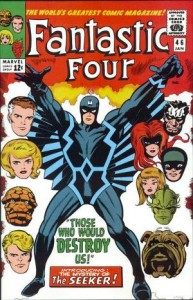 Fantastic Four 45-47 (12/65-2/66) “Among Us Hide the Inhumans” Hidden in the Himalayas in the 1960s was Marvel’s answer to Shangri La. Of course, it was peopled by super-powered, genetically manipulated alien-human hybrids, not Tibetan monks. The sheer imaginative scope of Lee and Kirby’s FF has never been equaled in super-hero comics. These three issues immediately precede the more famous, but perhaps less grounded, Galactus trilogy.
Fantastic Four 45-47 (12/65-2/66) “Among Us Hide the Inhumans” Hidden in the Himalayas in the 1960s was Marvel’s answer to Shangri La. Of course, it was peopled by super-powered, genetically manipulated alien-human hybrids, not Tibetan monks. The sheer imaginative scope of Lee and Kirby’s FF has never been equaled in super-hero comics. These three issues immediately precede the more famous, but perhaps less grounded, Galactus trilogy.
 Avengers 35-36 (12/66, 1/67) “The Ultroids Attack!” Again, not the most famous Avengers story, but a long-time favorite. The team returns to the Scarlet Witch and Quicksilver’s hometown in the Balkans, only to learn that aliens have taken over the village. It’s a combination of Invasion of the Body Snatchers and Universal’s Frankenstein films. And, very uncharacteristically, even for today, the Avengers team is almost half-female, featuring the Wasp, the Scarlet Witch and the Black Widow.
Avengers 35-36 (12/66, 1/67) “The Ultroids Attack!” Again, not the most famous Avengers story, but a long-time favorite. The team returns to the Scarlet Witch and Quicksilver’s hometown in the Balkans, only to learn that aliens have taken over the village. It’s a combination of Invasion of the Body Snatchers and Universal’s Frankenstein films. And, very uncharacteristically, even for today, the Avengers team is almost half-female, featuring the Wasp, the Scarlet Witch and the Black Widow.
 Incredible Hulk 118 (8/69) The Hulk vs. the Sub-Mariner – this single issue represents so many classically Marvel themes: political intrigue, jealousy, heroes battling each other (organically, not because half of them had their personalities raped by a careless author, as in Civil War), the tragic outsider, a beautiful, fascinating woman caught between opponents… I think this is why Stan Lee picked it for Origins of Marvel Comics, and it’s why I pick it here.
Incredible Hulk 118 (8/69) The Hulk vs. the Sub-Mariner – this single issue represents so many classically Marvel themes: political intrigue, jealousy, heroes battling each other (organically, not because half of them had their personalities raped by a careless author, as in Civil War), the tragic outsider, a beautiful, fascinating woman caught between opponents… I think this is why Stan Lee picked it for Origins of Marvel Comics, and it’s why I pick it here.
 X-Men (Uncanny X-Men, if you want to look it up on Marvel.com, but it was no such thing in 1969!) 56-63 (5/69 – 12/69) – Roy Thomas, Neal Adams and Tom Palmer’s X-Men. Neal Adams is one of the most famous of comics pencillers. An illustrator, as opposed to a cartoonist like the great Joe Staton, Adams’s style actually doesn’t fit that well with a lot of comic books. It’s too static, too grounded in reality. Jack Kirby, who created the (now-forgotten) Marvel “look,” never drew anything that looked realistic. He drew things that looked, pardon me, Fantastic. But Kirby’s style never really lit up the pages of X-Men, even though some of the characters he designed for the book are icons (Cyclops, Magneto, the Scarlet Witch, the Sentinels…) Adams, with Palmer’s inks, was perfect for the late run of the original X-Men. The young mutants were out on their own, their mentor dead, facing “reality” for the first time. Being suddenly drawn in a photo-realistic style just worked, much better than it did over on Avengers. It worked artistically, anyway. The new look didn’t save the title. But it’s second only to the Claremont/Cockrum/Byrne/Austin run for sheer storytelling power.
X-Men (Uncanny X-Men, if you want to look it up on Marvel.com, but it was no such thing in 1969!) 56-63 (5/69 – 12/69) – Roy Thomas, Neal Adams and Tom Palmer’s X-Men. Neal Adams is one of the most famous of comics pencillers. An illustrator, as opposed to a cartoonist like the great Joe Staton, Adams’s style actually doesn’t fit that well with a lot of comic books. It’s too static, too grounded in reality. Jack Kirby, who created the (now-forgotten) Marvel “look,” never drew anything that looked realistic. He drew things that looked, pardon me, Fantastic. But Kirby’s style never really lit up the pages of X-Men, even though some of the characters he designed for the book are icons (Cyclops, Magneto, the Scarlet Witch, the Sentinels…) Adams, with Palmer’s inks, was perfect for the late run of the original X-Men. The young mutants were out on their own, their mentor dead, facing “reality” for the first time. Being suddenly drawn in a photo-realistic style just worked, much better than it did over on Avengers. It worked artistically, anyway. The new look didn’t save the title. But it’s second only to the Claremont/Cockrum/Byrne/Austin run for sheer storytelling power.
 Captain America 169-176 (1/74 – 8/74) – The Secret Empire saga – Beginning in 1968, comic books started to change dramatically, with more striking art, heroes shedding their colorful costumes and becoming more gritty, and strong themes of social morality being brought to fore. For a while, as in O’Neill and Adams’s Green Lantern/Green Arrow, the “new” outweighed the “comic” in the new comics. Readers were beaten over the head with change. In the 1970s, the pendulum swung back a little, and creators stopped showing off and started reinventing comics in a way that kept them entertaining, but still brought them into the present day. I guess we all think the decade in which we became readers is comics’ greatest decade, but I think I can make quite an argument for the 1970s. It was after super-heroes became real people with flaws and feelings, but before major character death became the only storytelling device readers actually responded to.
Captain America 169-176 (1/74 – 8/74) – The Secret Empire saga – Beginning in 1968, comic books started to change dramatically, with more striking art, heroes shedding their colorful costumes and becoming more gritty, and strong themes of social morality being brought to fore. For a while, as in O’Neill and Adams’s Green Lantern/Green Arrow, the “new” outweighed the “comic” in the new comics. Readers were beaten over the head with change. In the 1970s, the pendulum swung back a little, and creators stopped showing off and started reinventing comics in a way that kept them entertaining, but still brought them into the present day. I guess we all think the decade in which we became readers is comics’ greatest decade, but I think I can make quite an argument for the 1970s. It was after super-heroes became real people with flaws and feelings, but before major character death became the only storytelling device readers actually responded to.
The Secret Empire storyline, about a president and corporate America being taken over by a villainous underground, broke new ground for social satire in comics, and, shockingly, ended with the suicide of a U.S. President. Today we think House of Cards is shocking. Imagine how comic readers felt in 1974! Storylines like The Winter Solider, in both comics and movies, were heavily advised by the work Steve Englehart and Sal Buscema did here, a fact almost unknown to modern fans. Plus this story guested the X-Men, whose own book was canceled.
 Avengers 141 – 149 (November, 1975 – July 1976) The Serpent Crown saga. The Avengers travel to a parallel Earth to battle that planet’s heroes, the Squadron Supreme, for an enchanted relic of great power. Here, Englehart brought the concept of parodying your rival to epic levels. The Squadron were designed to be a JLA knockoff, everybody knew it, and JLA writer Mike Friedrich was complicit when Avengers writer Roy Thomas first dreamed the parody up. Friedrich did his own parody of the Avengers in the pages of JLA, but it didn’t have the Squadron’s staying power. Along the way, Englehart deepened the power and characterizations of the Vision and the Scarlet Witch, who became his signature pair, and turned longtime Marvel romance icon Patsy Walker into the formidable Hellcat. His tip of the hat to fandom as inspiration in Patsy’s capsule biography is particularly nice. This was Englehart’s last storyline for the Assemblers, after a 45-issue run. He returned a decade later to write the West Coast Avengers, where his “Lost in Space Time” arc introduced the first battle between Avengers over killing, between husband and wife Hawkeye and Mockinbird no less. In the same storyline, he redeemed the badly broken Hank Pym, who was sacrificed years before to the gods of shallow relevancy so Jim Shooter could tell a story that was an insult to all real victims of domestic violence.
Avengers 141 – 149 (November, 1975 – July 1976) The Serpent Crown saga. The Avengers travel to a parallel Earth to battle that planet’s heroes, the Squadron Supreme, for an enchanted relic of great power. Here, Englehart brought the concept of parodying your rival to epic levels. The Squadron were designed to be a JLA knockoff, everybody knew it, and JLA writer Mike Friedrich was complicit when Avengers writer Roy Thomas first dreamed the parody up. Friedrich did his own parody of the Avengers in the pages of JLA, but it didn’t have the Squadron’s staying power. Along the way, Englehart deepened the power and characterizations of the Vision and the Scarlet Witch, who became his signature pair, and turned longtime Marvel romance icon Patsy Walker into the formidable Hellcat. His tip of the hat to fandom as inspiration in Patsy’s capsule biography is particularly nice. This was Englehart’s last storyline for the Assemblers, after a 45-issue run. He returned a decade later to write the West Coast Avengers, where his “Lost in Space Time” arc introduced the first battle between Avengers over killing, between husband and wife Hawkeye and Mockinbird no less. In the same storyline, he redeemed the badly broken Hank Pym, who was sacrificed years before to the gods of shallow relevancy so Jim Shooter could tell a story that was an insult to all real victims of domestic violence.
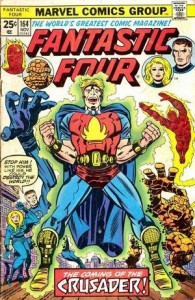 Fantastic Four 164-165 (11/75, 12/75) “The Crusader Syndrome!” Roy Thomas was the king of reviving Golden Age characters, at Marvel, anyway. Roy loved the comics of the 1940s, and brought those old heroes into the modern setting wherever he could. He created super-teams the Invaders and the Liberty Legion in the 1970s to house WWII veteran heroes in new stories, then moved over to DC and brought us All-Star Squadron and Young All-Stars for the same purpose. In this case, though, he didn’t go for straight nostalgia. He brought back 1950s hero Marvel Boy (so-named before his publisher had taken the name “Marvel”) and wrote him into a darker, more disturbing context. When he meets the FF, Marvel Boy is all grown up, his world and family (he was an Earthling child raised on Neptune) are dead, and poor Marvel Boy, now the Crusader, is pretty much crazy. It’s a tragic, tragic tale, in which you feel great sympathy for the “villain.” The only downside to it is that, once it inspired me to go find some original Marvel Boy stories, I decided I really liked the character. It was sad how he ended in FF. But stay tuned. He got better. Worthy of note: I took Marvel to task because their mega-list underrepresented some decades, and, indeed, did not touch the 1950s at all. Well, this is as close as I can come to celebrating 1950s Marvel. Or… Wait… I’ll get closer below.
Fantastic Four 164-165 (11/75, 12/75) “The Crusader Syndrome!” Roy Thomas was the king of reviving Golden Age characters, at Marvel, anyway. Roy loved the comics of the 1940s, and brought those old heroes into the modern setting wherever he could. He created super-teams the Invaders and the Liberty Legion in the 1970s to house WWII veteran heroes in new stories, then moved over to DC and brought us All-Star Squadron and Young All-Stars for the same purpose. In this case, though, he didn’t go for straight nostalgia. He brought back 1950s hero Marvel Boy (so-named before his publisher had taken the name “Marvel”) and wrote him into a darker, more disturbing context. When he meets the FF, Marvel Boy is all grown up, his world and family (he was an Earthling child raised on Neptune) are dead, and poor Marvel Boy, now the Crusader, is pretty much crazy. It’s a tragic, tragic tale, in which you feel great sympathy for the “villain.” The only downside to it is that, once it inspired me to go find some original Marvel Boy stories, I decided I really liked the character. It was sad how he ended in FF. But stay tuned. He got better. Worthy of note: I took Marvel to task because their mega-list underrepresented some decades, and, indeed, did not touch the 1950s at all. Well, this is as close as I can come to celebrating 1950s Marvel. Or… Wait… I’ll get closer below.
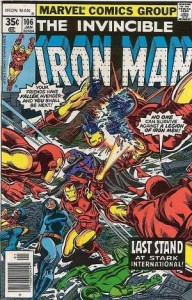 Iron Man 103 – 107 (10/77 – 2/78) – The Midas Takeover – Bill Mantlo is one of the most underrated writers Marvel had in the 1970s. This arc on Iron Man, wherein super-villain Midas takes over Stark Industries, and Tony must ally himself with Madame Masque, Jack of Hearts, Guardsman, Jean DeWolff and the Wraith to get his company back, is my all time favorite Iron Man story. The use of supporting characters is magnificent. Mantlo left the book about six months after this, and it became very popular under David Michelinie. I didn’t like the fact that they turned Madame Masque against Tony, however, so I didn’t stick with it. Bethany Cabe was no Madame Masque. Ironically, Mantlo was slated to take The Avengers over from Michelinie not longer after that. He had proved himself capable of handling a team book, and I think he would have done great things. But then-Editor-in-Chief Jim Shooter didn’t care for Mantlo, however, and has actually accused him, in public, of plagiarism. So Shooter took the Avengers himself. With staggeringly poor results. For more of Mantlo’s handling of a team story, see Marvel Team-Up Annual #1, featuring Spider-Man and the X-Men.
Iron Man 103 – 107 (10/77 – 2/78) – The Midas Takeover – Bill Mantlo is one of the most underrated writers Marvel had in the 1970s. This arc on Iron Man, wherein super-villain Midas takes over Stark Industries, and Tony must ally himself with Madame Masque, Jack of Hearts, Guardsman, Jean DeWolff and the Wraith to get his company back, is my all time favorite Iron Man story. The use of supporting characters is magnificent. Mantlo left the book about six months after this, and it became very popular under David Michelinie. I didn’t like the fact that they turned Madame Masque against Tony, however, so I didn’t stick with it. Bethany Cabe was no Madame Masque. Ironically, Mantlo was slated to take The Avengers over from Michelinie not longer after that. He had proved himself capable of handling a team book, and I think he would have done great things. But then-Editor-in-Chief Jim Shooter didn’t care for Mantlo, however, and has actually accused him, in public, of plagiarism. So Shooter took the Avengers himself. With staggeringly poor results. For more of Mantlo’s handling of a team story, see Marvel Team-Up Annual #1, featuring Spider-Man and the X-Men.
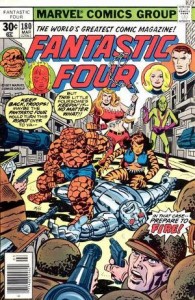 Fantastic Four 177 – 183 (12/76 – 12/77) “Call My Killer The Brute” Roy Thomas was handling the scripting chores during this period that some might not consider the FF’s strongest, but, again, wonderful use of supporting characters, a character-driven plot and the returns of a dozen or so classic FF villains made this a thoroughly enjoyable extended storyline in the days when it was still rare for a story to run six issues. Along with epics like “The Serpent Crown” and “The Secret Empire,” the saga of The Brute replacing Mr. Fantastic as leader of the FF paved the way for the six-and-twelve issue “trade-sized” comic stories that are all we get today. It also was the first time that pretty much the entire team was side-lined, at least for a little while, by a whole new cast of characters. (Sue had been replaced twice, by Crystal and then Medusa, and Ben had been replaced with Luke Cage in one story, but this time, Sue, Reed and Johnny are all absent, and their replacements, Tigra, Thundra and the Impossible Man, comprised a team the likes of which would not be seen again until the arrival of the Great Lakes Avengers.) Ironically, the cover I show here was not featured on the issue that introduced this “new” team. A missed deadline caused this cover to go on a reprint, while the actual story appeared the following month with a generic cover.
Fantastic Four 177 – 183 (12/76 – 12/77) “Call My Killer The Brute” Roy Thomas was handling the scripting chores during this period that some might not consider the FF’s strongest, but, again, wonderful use of supporting characters, a character-driven plot and the returns of a dozen or so classic FF villains made this a thoroughly enjoyable extended storyline in the days when it was still rare for a story to run six issues. Along with epics like “The Serpent Crown” and “The Secret Empire,” the saga of The Brute replacing Mr. Fantastic as leader of the FF paved the way for the six-and-twelve issue “trade-sized” comic stories that are all we get today. It also was the first time that pretty much the entire team was side-lined, at least for a little while, by a whole new cast of characters. (Sue had been replaced twice, by Crystal and then Medusa, and Ben had been replaced with Luke Cage in one story, but this time, Sue, Reed and Johnny are all absent, and their replacements, Tigra, Thundra and the Impossible Man, comprised a team the likes of which would not be seen again until the arrival of the Great Lakes Avengers.) Ironically, the cover I show here was not featured on the issue that introduced this “new” team. A missed deadline caused this cover to go on a reprint, while the actual story appeared the following month with a generic cover.
 X-Men 125 – 128 (9/79 – 12/79) “Proteus” If you could only read one storyline from the Claremont-Byrne-Austin X-Men days, this would be the one you should pick. Yes, Dark Phoenix was a triumph. (Though, in retrospect, I dislike the re-written ending that Jim Shooter demanded. I actually prefer the ending written years later for the animated series.) But Dark Phoenix was the capstone, and, really, the eulogy, to a great achievement. You really need to savor the achievement itself before the Dark Phoenix saga can pack real punch. You need to understand what was lost when Jean Grey died and Scott Summers left the team. The Proteus saga was the X-Men at their best–scary, funny, heart-warming, sad. The team had been split for twelve issues, and this storyline brought them all back together to work as a team. It was the best of the “regular” run, before the Dark Phoenix saga brought it all to a close. (Technically, there were four issues after Dark Phoenix, and two of them were the seminal “Days of Future Past.” But, since they were the story of a very different X-Men team, they again don’t really bring across what it was that made the X-Men the most popular book at Marvel.)
X-Men 125 – 128 (9/79 – 12/79) “Proteus” If you could only read one storyline from the Claremont-Byrne-Austin X-Men days, this would be the one you should pick. Yes, Dark Phoenix was a triumph. (Though, in retrospect, I dislike the re-written ending that Jim Shooter demanded. I actually prefer the ending written years later for the animated series.) But Dark Phoenix was the capstone, and, really, the eulogy, to a great achievement. You really need to savor the achievement itself before the Dark Phoenix saga can pack real punch. You need to understand what was lost when Jean Grey died and Scott Summers left the team. The Proteus saga was the X-Men at their best–scary, funny, heart-warming, sad. The team had been split for twelve issues, and this storyline brought them all back together to work as a team. It was the best of the “regular” run, before the Dark Phoenix saga brought it all to a close. (Technically, there were four issues after Dark Phoenix, and two of them were the seminal “Days of Future Past.” But, since they were the story of a very different X-Men team, they again don’t really bring across what it was that made the X-Men the most popular book at Marvel.)
 Vision and the Scarlet Witch (10/85 – 9/86) One of the first “Maxi-Series” published, this chronicled a year in the life of former Avengers the Vision and the Scarlet Witch. Steve Englehart, who had breathed life into the two a decade before, returned to guide them as they tackled suburban life and parenthood. This was a totally different type of book, with lots of super-hero action, but also a lot of the sensibilities of a romance comic, and elements of soap opera and sitcom. It was all about the characters and their relationship, with no shock, no awe, just growth. It introduced the idea that a true witch could take a piece of her own soul, a piece of her android husband’s, and quicken life, resulting in the births of Tommy and Billy, two mutants who would later become Speed and Wiccan of the Young Avengers. (Many writers tried hard to wipe these two out of existence, but they’re back. See below. Sadly, they’re not referred to only as the Scarlet Witch’s sons.)
Vision and the Scarlet Witch (10/85 – 9/86) One of the first “Maxi-Series” published, this chronicled a year in the life of former Avengers the Vision and the Scarlet Witch. Steve Englehart, who had breathed life into the two a decade before, returned to guide them as they tackled suburban life and parenthood. This was a totally different type of book, with lots of super-hero action, but also a lot of the sensibilities of a romance comic, and elements of soap opera and sitcom. It was all about the characters and their relationship, with no shock, no awe, just growth. It introduced the idea that a true witch could take a piece of her own soul, a piece of her android husband’s, and quicken life, resulting in the births of Tommy and Billy, two mutants who would later become Speed and Wiccan of the Young Avengers. (Many writers tried hard to wipe these two out of existence, but they’re back. See below. Sadly, they’re not referred to only as the Scarlet Witch’s sons.)
 Avengers Forever 1 – 12 (12/98 – 2/00) – Big jump in time here. Remember how Marvel skipped the Fifties? Yeah, well, I almost skipped the 90s. Deservedly so, since very little good happened at Marvel in the 90s, until Kurt Busiek started writing the Avengers. Kurt Busiek, Carlos Pacheco and Jesus Merino put together this epic, time-traveling tale of the once and future Avengers. Along the way they made the 1950s Avengers from a What If story canon, they re-instituted the connection between android heroes the Vision and the Human Torch (wiped out at the same time as the Vision’s children and his human personality in 1989) and they made Yellowjacket cool again.
Avengers Forever 1 – 12 (12/98 – 2/00) – Big jump in time here. Remember how Marvel skipped the Fifties? Yeah, well, I almost skipped the 90s. Deservedly so, since very little good happened at Marvel in the 90s, until Kurt Busiek started writing the Avengers. Kurt Busiek, Carlos Pacheco and Jesus Merino put together this epic, time-traveling tale of the once and future Avengers. Along the way they made the 1950s Avengers from a What If story canon, they re-instituted the connection between android heroes the Vision and the Human Torch (wiped out at the same time as the Vision’s children and his human personality in 1989) and they made Yellowjacket cool again.
 Young Avengers 1 – 12 (4/05 – 8/06) At a time when the regular Avengers book was just something I couldn’t take anymore, Young Avengers came along, with new, appealing characters developed by TV writer Allan Heinberg. The story undid a fifteen-year-old crime, the wiping from existence of Vision and Wanda’s kids. This was nice, because the Vision was dead and his now-ex-wife was in disgrace, partially for killing him. So at least the kids got a pseudo-happy ending, becoming part of a new Avengers team. And Billy (Wiccan) was also gay and part of a happy couple, making him and his boyfriend Hulkling, I believe, the first openly gay teen super-hero couple in comics.
Young Avengers 1 – 12 (4/05 – 8/06) At a time when the regular Avengers book was just something I couldn’t take anymore, Young Avengers came along, with new, appealing characters developed by TV writer Allan Heinberg. The story undid a fifteen-year-old crime, the wiping from existence of Vision and Wanda’s kids. This was nice, because the Vision was dead and his now-ex-wife was in disgrace, partially for killing him. So at least the kids got a pseudo-happy ending, becoming part of a new Avengers team. And Billy (Wiccan) was also gay and part of a happy couple, making him and his boyfriend Hulkling, I believe, the first openly gay teen super-hero couple in comics.
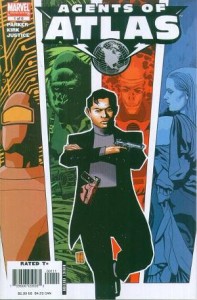 Agents of Atlas (10/06 – 3/07) Following on the heels of Avengers Forever, writer Jeff Parker made a name for himself resurrecting five characters from Marvel’s days as “Atlas Comics” in the 1950s: Marvel Boy, Venus, the Human Robot, Gorilla-Man and Jimmy Woo. Actually, Roy Thomas had created this team in an early issue of What-If, as an answer to the question, “What if the Avengers had existed in the 1950s?” This is solid, team-based, character-driven storytelling.
Agents of Atlas (10/06 – 3/07) Following on the heels of Avengers Forever, writer Jeff Parker made a name for himself resurrecting five characters from Marvel’s days as “Atlas Comics” in the 1950s: Marvel Boy, Venus, the Human Robot, Gorilla-Man and Jimmy Woo. Actually, Roy Thomas had created this team in an early issue of What-If, as an answer to the question, “What if the Avengers had existed in the 1950s?” This is solid, team-based, character-driven storytelling.
And there it is. Disagree if you like. But I think these stories represent something that was missing from Marvel’s version. Fortunately, a lot of these stories are still advising their movie series!

Great list. Lots of great memories there.
Nice list. I wonder about your age when you read the older stuff mostly because many of the early Marvels are from the time when I was a teen thru to my late twenties. I haven’t read everything on your list but the stuff I have read is all good to great. Really enjoyed Avengers Forever as well, a real highlight in Avengers stories. As a Marvel Unlimited subscriber I think I’ll give that Iron Man story a look. Anyway, cool list.
Pingback: Legion of Super-Heroes Re-Read - "The Legion Chain Gang!" (Adventure Comics #360, September, 1967) - Steven H. WilsonSteven H. Wilson